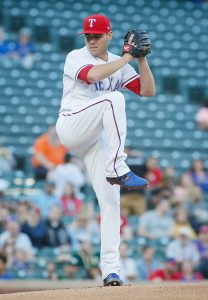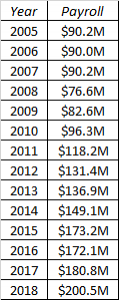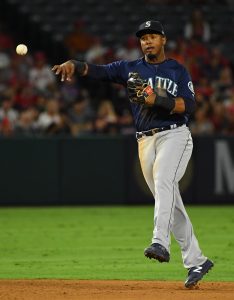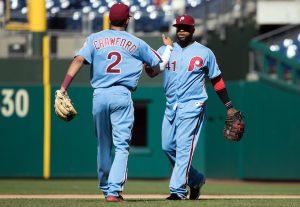MLBTR is publishing Offseason Outlooks for all 30 teams. Click here to read the other entries in this series.
The Brewers went from a near-miss in the 2017 postseason to a deep NLCS run against the Dodgers in 2018. With much of the core under control, general manager David Stearns and the rest of the Milwaukee front office will look to push the roster to the next level in 2019.
Guaranteed Contracts
- Lorenzo Cain, OF: $66MM through 2022
- Ryan Braun, OF: $38MM through 2020 (includes $4MM buyout of 2021 mutual option)
- Christian Yelich, OF: $37.5MM through 2021 (includes $1.25MM buyout of 2022 club option)
- Eric Thames, 1B/OF: $7MM through 2019 (includes $1MM buyout of 2020 club option)
- Chase Anderson, RHP: $6.5MM through 2019 (includes $500K buyout of 2020 club option; contract also contains 2021 club option)
- Jhoulys Chacin, RHP: $6MM through 2019
- Jeremy Jeffress, RHP: $3.175MM through 2019 (contract contains 2020 club option)
- Matt Albers, RHP: $2.5MM through 2019
- Erik Kratz, C: $1.5MM through 2019 (as a pre-tender arbitration contract, Kratz’s deal is not fully guaranteed)
Arbitration-Eligible Players (service time in parentheses; salary projections via MLBTR contributor Matt Swartz)
- Travis Shaw (3.088) – $5.1MM
- Corey Knebel (3.151) – $4.9MM
- Jimmy Nelson (4.107) – $3.7MM
- Hernan Perez (4.079) – $2.7MM
- Junior Guerra (2.155) – $2.7MM
- Zach Davies (3.020) – $2.4MM
- Domingo Santana (3.024) – $2.0MM
- Manny Pina (3.046) – $1.8MM
- Tyler Saladino (3.053) – $1.0MM
[Brewers depth chart | Brewers current payroll outlook | Brewers payroll projection analysis]
Free Agents
- Jonathan Schoop, Gio Gonzalez, Mike Moustakas, Joakim Soria, Wade Miley, Curtis Granderson, Jordan Lyles, Xavier Cedeno, Dan Jennings, Stephen Vogt, Eric Sogard
Generally speaking, there aren’t going to be a lot of holes to fill for a 96-win team that stands to retain the vast majority of its top players, but that’s perhaps less so in the case of these Brewers. Milwaukee’s outfield is set, if not overcrowded, but the Brewers’ infield, catching and rotation pictures all present the opportunity for improvement.
The Brewers bit the bullet and non-tendered Jonathan Schoop — a supposedly key trade-deadline acquisition who instead flopped in his limited time in Milwaukee. With Mike Moustakas, whose midseason acquisition was much more successful, hitting the open market and Orlando Arcia still not fully cemented as an everyday player in the big leagues, the Brewers could pursue multiple avenues to solidifying their infield mix.
Travis Shaw has proven a quality third baseman for the past two seasons in Milwaukee, but he shifted to second base at times when the club added Moustakas to the fold. Presumably, given the fact that Shaw grades out as a strong defender at the hot corner, the Brewers wish to return him to third base. At the very least, Milwaukee could stand to add a second baseman, where utilityman Hernan Perez currently tops the depth chart. Fortunately for the Brewers, there’s hardly a shortage of options available to them.
Frankly, it’s possible to imagine a variety of approaches, including the addition of multiple pieces that will see action at multiple positions. Super-utilityman Marwin Gonzalez would be an intriguing fit, and he’s certainly familiar to Stearns. But he may well cost more than the Brewers wish to pay. It’s not hard to imagine Stearns looking to find his own such player at a more palatable rate of pay.
DJ LeMahieu and Jed Lowrie head up a deep free-agent crop of second basemen. The former would bring some relative youth and premium defense to the position; the latter, meanwhile, is coming off a career-best season and offers more defensive versatility, though Lowrie will play next season at age 35. With top prospect Keston Hiura already reaching Double-A, the Brewers probably don’t feel the need to spend heavily on a long-term option at second base, and likely won’t be forced to in this market. Any of Brian Dozier, Daniel Murphy, Ian Kinsler or Asdrubal Cabrera could presumably be had on short-term pacts (in some cases, even one-year deals), and the trade market also features myriad options. Starlin Castro and Cesar Hernandez could be shorter-term options, while someone such as Arizona’s Ketel Marte is a longer-term piece who has the versatility to move to a utility role if Hiura pushes him off the spot. Stearns is never shy on the trade market, and he’ll have ample avenues to explore in that regard.
At shortstop, the need is less acute. Arcia was one of the game’s worst hitters in the first half of the season, but the former top prospect returned from a brief demotion to hit .290/.320/.386 in his final 154 plate appearances before hitting .333/.353/.606 in 34 trips to the plate in the postseason. Given his strong defensive ratings at short, his once-premium prospect pedigree and the fact that he’s headed into his age-24 season, there’s reason to believe that Arcia can hold down the fort in 2019 at the very least — if not blossom into a close approximation of the player he was projected to be when ranked as a top 10 prospect in the entire game. If anything, perhaps a glove-first utility option to support Arcia could make sense — someone in the mold of Freddy Galvis.
For a second consecutive offseason, the Brewers could explore the market for help behind the plate. Manny Pina regressed in most offensive respects in 2018, but to his credit, he improved substantially in terms of pitch framing, pitch blocking and halting stolen bases. Pina turned in a terrific defensive season but hit just .252/.307/.395. At present, he’s projected to pair with affable veteran Erik Kratz, who hit .236/.280/.355 while serving as a fan favorite and clubhouse leader. It’s a defensively sound pairing but one that also lacks much offensive upside. If the Brewers want to again try to pry a Marlins star out of Miami, they’d be a fairly natural landing spot for J.T. Realmuto, who’d bring a more well-rounded approach to the table. To date, there’s no real indication of how high a priority the club places on improving in this area, but there are quite a few other plausible targets floating around the market at different price points.
Turning to the pitching staff, Stearns and his lieutenants did well to prove that the public outcry for more rotation help last offseason was exaggerated. The Brewers will welcome Jimmy Nelson back to a starting staff that should feature a combination of Jhoulys Chacin, Chase Anderson, Zach Davies, Junior Guerra, Freddy Peralta, Brandon Woodruff and Corbin Burnes. It’s a quality mix of arms with some significant upside in the form of Nelson and Burnes. The standard adage that one can never have too much starting pitching always applies, and acquiring a clear top-of-the-rotation arm could allow the Brewers to deal from that depth to address other needs, but an impact starter is far more a luxury than a necessity for Milwaukee this winter. Milwaukee has often been mentioned as a possible landing spot for Sonny Gray, which would deepen that mix and add some potential upside to an already promising group. There’s also certainly an argument the Brewers should go bigger if they’re to make a move. The club has been connected to Noah Syndergaard, though that seems a remote possibility.
In the bullpen, the Brewers will return much of the unit that proved to be arguably the club’s greatest strength in 2018. Josh Hader, Corey Knebel and Jeremy Jeffress were an utterly dominant trio at the back of the Milwaukee ’pen for much of the season. The latter of that group may have worn down a bit in the postseason, but without the Herculean regular-season efforts of any of that threesome, the Brewers may not have been in the playoffs at all. They’ll likely be joined by veteran Matt Albers, Jacob Barnes and at least one of the rotation candidates who doesn’t end up winning a starting job this spring. But the Brewers could stand to strengthen an existing strength — particularly in the form of a left-handed reliever. Zach Britton and Andrew Miller are the top free agents out there, but Stearns hasn’t spent heavily on the ’pen in free agency since taking the reins in Milwaukee. The market has some bargain options and upside plays in the form of Oliver Perez, Zach Duke, Tyler Lyons and Jake Diekman, among others. An affordable southpaw option to pair with Hader, the resident late-inning juggernaut, would seem prudent.
Beyond filling out those needs, however, the Brewers face some surpluses with which to deal. The Brew Crew was happy to stockpile outfielders last season, knowing that players like Keon Broxton and Domingo Santana had minor league options remaining and could be shuttled back and forth from Triple-A to the Majors as needed. That won’t be the case next season, and with Yelich, Cain and Braun lined up in the outfield — Braun possesses a no-trade clause — the front office will have to make some tough decisions. Both Santana and Broxton are out of minor league options, making them obvious trade candidates this winter. Either could be used to help address the bullpen, infield or catching situations. With three and four years of club control left, respectively, neither is an extremely long-term asset, but they could very well still hold appeal to organizations such as the Indians, White Sox, and Giants that are in need of some outfield options.
It seems likely that Eric Thames will also see his name bandied about the rumor circuit this offseason. Jesus Aguilar’s ascension to primary first baseman and the outfield logjam have left Thames as something of an odd man out. It doesn’t help that the former KBO star took a step backward in his second season back in the Majors, hitting .219/.306/.478 in 278 plate appearances. Thames’ overall .237/.341/.504 slash in two seasons as a Brewer is still productive, though, and for a club seeking an affordable first base or corner outfield option (e.g. Twins, Rockies), the lefty slugger could be a reasonable target.
As MLBTR contributor Rob Huff noted in analyzing the Brewers’ payroll, the current roster construction leaves Milwaukee with around $15MM to spend — based on historically plausible payroll expectations in Milwaukee. However, moving someone such as Thames, Santana or Albers could create a bit of extra room. Beyond that, given a deep playoff run in 2018, perhaps owner Mark Attanasio will be content to push the envelope a bit further in terms of what he’ll spend on the 2019 roster.
Fortunately, the Brewers are lacking in a clear, glaring need. The rotation could be improved, but Nelson’s return and the emergence of Burnes, Peralta and Woodruff create a deep reservoir of arms from which to draw. Arcia showed signs of life at shortstop late in the season, and a short-term addition could bridge the second-base gap to Hiura. Neither Pina nor Kratz is a highly exciting option behind the dish, but it’s a sturdy enough pairing to support a young pitching staff. The bullpen’s top three spots are locked in, and some of the rotation mix figures to join the group.
None of that is to say that the Brewers don’t need to or won’t make some additions to bolster their chances in 2019. They assuredly will. But, rather than zero in on one specific area of need, Stearns and his staff can take a broad, value-based approach to looking at the best ways to improve the current collection of talent. That general tact has paid dividends (and produced surprises) over the past two seasons, so it’ll be interesting to see what the front office comes up with this time around.






